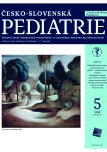Severe congenital bleeding disorders manifesting in the neonatal period – case reports
Authors:
Jadvidžáková Eva; Šrámková Lucie; Komrska Vladimír; Starý Jan; Zápotocká Ester
Authors‘ workplace:
Klinika dětské hematologie a onkologie, 2. lékařská fakulta Univerzity Karlovy a Fakultní nemocnice v Motole, Praha
Published in:
Čes-slov Pediat 2022; 77 (5): 287-292.
Category:
Case Report
doi:
https://doi.org/10.55095/CSPediatrie2022/046
Overview
Congenital bleeding disorders are rare diseases. In case of a positive family history, especially in hemophilia, it is very important to prepare a plan for the birth of a child, taking into account an increased risk of bleeding. After birth of such a child, cooperation with a hematologist is key in performing necessary laboratory tests and other examinations. In a number of cases, however, the family history is silent, and the suspicion of a congenital bleeding disease arises only in the presence of bleeding associated with invasive procedures or, for example, intracranial bleed. In such case, rapid diagnosis is necessary, taking into account possible abnormal results of screening tests, ideally in collaboration with a hematologist. Replacement treatment of the coagulation disorder can stop the bleeding and prevent more severe damage or even death of the child.
Keywords:
newborn – inherited coagulation disorders – intracranial hemorrhage
Sources
1. Sutor AH, von Kries R, Cornelissen EA, et al. Vitamin K deficiency bleeding (VKDB) in infancy. ISTH Pediatric/Perinatal Subcommittee. International Society on Thrombosis and Haemostasis, Thromb Haemost 1999; 81(3): 456–61.
2. Formoso VR, Mota RB, Soares H. Developmental hemostasis in the neonatal period, World J Pediatr 2022; 18: 7–15.
3. Keir AK, Stanworth SJ. Neonatal plasma transfusion: an evidence-based review. Transfus Med Rev 2016; 30: 174–182.
4. Kaczor DA, Depasse F, Sevenet PO. Factor VII deficiency: from basics to clinical laboratory diagnosis and patient management. Clin Appl Thromb Hemost 2017; 23(7): 703–710.
5. Lee CA, et al. Textbook of hemophilia. 2nd ed. 2010: 110–114.
6. Srivastava A, Santagostino E, Dougall A, et al. WFH Guidelines for the Management of Hemophilia, 3rd ed. Haemophilia 2020: 26(Suppl 6): 1–158.
7. Zapletal O, Blatný J, Ovesná P, et al. Intrakraniální krvácení u pacientů s hemofilií A. Čes-slov Pediat 2019; 74(4): 233–239.
8. Chalmers E, Williams M, Brennand J, et al. Guideline on the management of haemophilia in the fetus andneonate, BJH 2011; 154: 208–215.
9. Kletzel M, et al. Postdelivery head bleeding in hemophilic neonates, Arch J Dis Child 1989; 143; 1107–10.
10. Tarantino MD. Occurrence and management of severe bleeding episodes in patients with hereditary factor X deficiency. Haemophilia 2021; 27: 531–543.
11. Peyvandi F, Auerswald G, Austin SK, et al. Diagnosis, therapeutic advances, and key recommendations for the management of factor X deficiency. Blood Rev 2021; 50
Labels
Neonatology Paediatrics General practitioner for children and adolescentsArticle was published in
Czech-Slovak Pediatrics

2022 Issue 5
- What Effect Can Be Expected from Limosilactobacillus reuteri in Mucositis and Peri-Implantitis?
- The Importance of Limosilactobacillus reuteri in Administration to Diabetics with Gingivitis
Most read in this issue
- Hemorrhagic disease of the newborn caused by vitamin K deficiency
- Disseminated intravascular coagulation in children
- Algorithm for recognition a seriously ill child
- Inherited coagulation disorders
